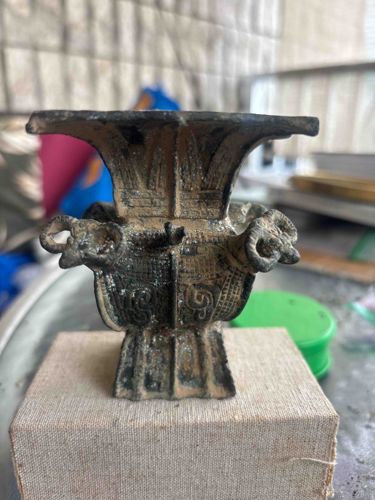
Ancient Chinese Bronze Gu-style Vessel with Ram Heads
This item is a bronze vessel, likely a 'Gu' type, characterized by its tall, slender form with an elongated trumpet-shaped mouth and a flared base. The vessel's primary material is bronze, exhibiting a dark, mottled patinathat is consistent with significant age and exposure to environmental elements, suggesting it is a buried or excavated artifact. The color is predominantly dark brown to black, with areas of lighter green or reddish-brown corrosion products visible in recesses and on raised surfaces, which is typical for ancient bronzes. Its construction appears to be cast, with visible seams or mold lines suggesting traditional ancient Chinese bronze casting techniques. Notable features include integral ram heads protruding from the central section of the vessel, just below the flared mouth. These ram heads are rendered with recognizable horns and facial features, adding a zoomorphic element to the design. The body of the vessel is adorned with intricate relief patterns, including what appears to be stylized 'taotie' masks or geometric motifs, characteristic of Shang or Zhou dynasty bronze work. These patterns are somewhat obscured by the heavy patina but are still discernible, particularly in the central and lower sections. The craftsmanship, despite the wear, indicates a high level of detail and artistic skill in the casting process. Visible condition issues include significant surface pitting, oxidation, and a thick, uneven patina. There are no immediate signs of repairs or major breaks, but the surface suggests considerable age and environmental interaction. The edges of the mouth and base show some irregularity and minor chipping due to age and handling. This vessel likely dates to an early period of Chinese history, possibly the Shang (c. 1600-1046 BC) or Western Zhou (c. 1046-771 BC) dynasties, given its form, decoration, and discernible casting methods. Its unique combination of the Gu-style form with prominent ram head adornments suggests a specific regional or temporal variation within ancient Chinese bronze art.
AI-Generated Appraisal Disclaimer
Estimated Value
$60,000-120,000
Basic Information
Category
Ancient Chinese Bronze Ritual Vessel
Appraised On
December 8, 2025
Estimated Value
$60,000-120,000
Item Description
This item is a bronze vessel, likely a 'Gu' type, characterized by its tall, slender form with an elongated trumpet-shaped mouth and a flared base. The vessel's primary material is bronze, exhibiting a dark, mottled patinathat is consistent with significant age and exposure to environmental elements, suggesting it is a buried or excavated artifact. The color is predominantly dark brown to black, with areas of lighter green or reddish-brown corrosion products visible in recesses and on raised surfaces, which is typical for ancient bronzes. Its construction appears to be cast, with visible seams or mold lines suggesting traditional ancient Chinese bronze casting techniques. Notable features include integral ram heads protruding from the central section of the vessel, just below the flared mouth. These ram heads are rendered with recognizable horns and facial features, adding a zoomorphic element to the design. The body of the vessel is adorned with intricate relief patterns, including what appears to be stylized 'taotie' masks or geometric motifs, characteristic of Shang or Zhou dynasty bronze work. These patterns are somewhat obscured by the heavy patina but are still discernible, particularly in the central and lower sections. The craftsmanship, despite the wear, indicates a high level of detail and artistic skill in the casting process. Visible condition issues include significant surface pitting, oxidation, and a thick, uneven patina. There are no immediate signs of repairs or major breaks, but the surface suggests considerable age and environmental interaction. The edges of the mouth and base show some irregularity and minor chipping due to age and handling. This vessel likely dates to an early period of Chinese history, possibly the Shang (c. 1600-1046 BC) or Western Zhou (c. 1046-771 BC) dynasties, given its form, decoration, and discernible casting methods. Its unique combination of the Gu-style form with prominent ram head adornments suggests a specific regional or temporal variation within ancient Chinese bronze art.
Related Tags
Explore similar items and categories:
Get Your Items Appraised
Instant estimates of your treasures with AI-powered instant appraisals